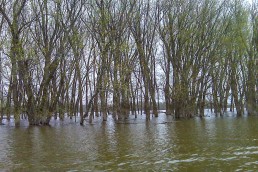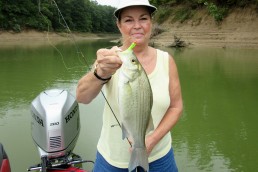High-water Bass Fishing on the Upper Mississippi
SHARE THIS POST
The Mississippi River around the Quad Cities is one of the best fisheries in the Midwest. What seemingly has changed over the past few years is the amount of flooding that seems to occur all summer long. This is a constant issue for bass fishermen and has really forced many to adapt their strategies.
The first thing to consider when you travel on the Mississippi River in high water is safety. The river is very different when at pool compared to flood stage. While staying between the red and green cans will essentially keep you out of trouble at pool, that is no guarantee during high water. There are a couple things that usually hold true during high water, though.
When the river is going up or down, the debris load is usually the heaviest. This is when you see entire trees, docks, and other large debris floating down the river, sometimes just above the waterline. If the high water has plateaued for several days, usually the debris levels diminish. One key is the water clarity. If the water is chocolate milk, then you best keep your eyes open. If the water has cleared up to normal summer clarity, then the debris is usually manageable. But, it is the river; never expect your travel path to be clear of obstruction.
Second, use those river conditions to predict where you might find largemouths. Bass can be caught in water that looks like a mud slurry, but it does not happen quickly. These fish use several senses to find and eat their prey. When the water is that muddy, they typically are closed mouthed, or have left the area. Fisherman should do the same.
Mind the rise and fall
Next, if you have a rising or falling river, use that to your advantage. This is especially true when you have different water clarities meeting. As the river levels change, the current patterns, transition zones, pinch points and active feeding areas all seem to change. My favorite time to bass fish is late spring through summer since the water is falling quickly. I have several spots that are so predictable that I have gone into tournaments without bothering to pre-fish. These spots typically drain small backwaters into the mainstem of the river. Bait as well as bass all come though these funnels. Typically, the key spots will be within 25-yards of those confluences. Usually, they’re directly adjacent to the funnel. If there is wood or other cover in these areas, you can basically drop the anchor and sit. On hard drops, there will be active fish continually coming through.
Are you enjoying this post?
You can be among the first to get the latest info on where to go, what to use and how to use it!
Bait selection is key to effectively fishing these areas. If the water is more creek-like than backwater lake, a crawfish bait may be more effective than a shad-based bait. Figuring out what the current “buffet line” is delivering to the fish can be the difference between a couple bites or wearing out a set of hooks. Once, during a four-hour evening tournament, we caught over thirty keepers out of a brush pile at the discharge point. A boat not ten feet away from us caught about a dozen, as well. Minor differences in baits (orange claws which matched the crawdads in the creek) were the key that evening for a near 18-pound bag at weigh-in and a much heavier wallet driving home.
Stay clean
During flat or rising water levels, go shallow and find clean water. There are exceptions, such as a deep pond or lakes that are now accessible due to the high water. Fish are not quite as predictable during this period as during falling water, but there are some general trends. First, look for hard bank—especially a stretch of shoreline that has a steep slope. These areas are typically not as sensitive to smaller changes in the river level. If you find one with clean water, slow down and work it carefully. These banks can hold a lot of fish. I recall a bank during a charity tournament, which was barely 25 yards long, that had over two dozen good keepers, and we spent two hours on that 25-yard stretch. Many other boats had passed it up with just a few casts. Slowly working and reworking that bank in late morning was critical to a successful day.
If you have not found one of these honey-holes, then keep moving. Search baits such as spinnerbaits, bladed baits, frogs and swimbaits are all good first choices. You are typically going to be in shallow, flooded vegetation or trees, so do not forget that push pole. Once you find fish, slow down and work the spot thoroughly with flippin’ baits because the fish can concentrate in big numbers. Blue/black jigs are hard to beat in nearly any condition, but make sure you work every spot and hole thoroughly.
The river can be a tough place to fish while flooded, but using these tips can turn a slow day into one you will never forget.
MWO
SHARE THIS POST
Did you enjoy this post?
You can be among the first to get the latest info on where to go, what to use and how to use it!
Jeremiah Haas
As a full-time fisheries biologist on the Mississippi River, Jeremiah Haas is intimately tied to the outdoor resources surrounding the greater Quad Cities area and the Upper Mississippi River Basin. An accomplished hunter, fisherman and writer, Haas offers unique insight and perspective to MidWest Outdoors readers.



